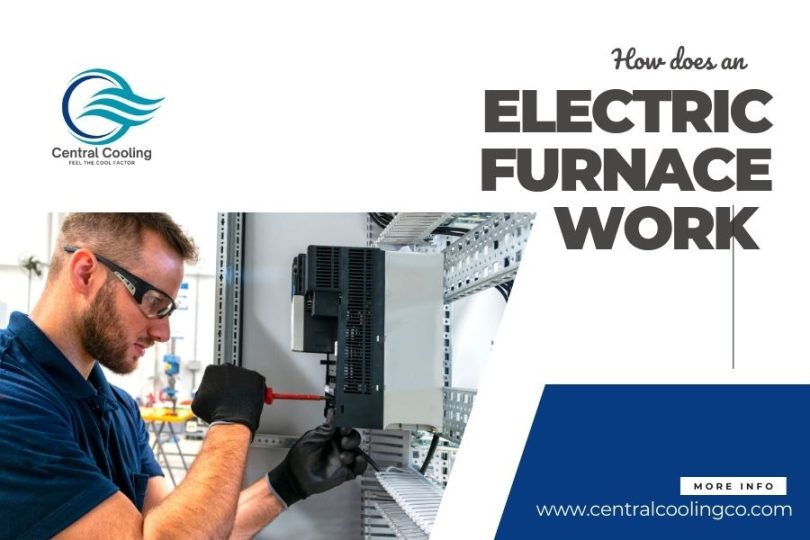Integral to home heating, Furnaces come in various types, each operating uniquely. The electric furnace stands out as a distinctive piece of machinery, operating like a giant hair dryer. Understanding how does an electric furnace work is crucial for homeowners looking to optimize their heating systems.
This article aims to demystify the workings of electric furnaces, drawing comparisons with their popular counterpart, the gas furnace, to provide a comprehensive understanding. We will delve into the operational mechanics, efficiency, costs, and environmental impacts of both heating systems, offering readers clarity on which option best suits their heating needs.
Unveiling The Mechanism: How Does A Furnace Work?
To grasp the intricacies of how an electric furnace operates, it’s essential first to comprehend the fundamental working principles shared by all furnaces. The journey from ancient campfires to modern central heating systems is rooted in the basic thermodynamic principle that heat can be transferred.
Imagine placing a kettle on an electric furnace—heat transfers from the furnace to the kettle, heating the water for your tea. Applying the same principle, modern heating systems transfer heat to the air, circulating it through rooms to create warm and comfortable spaces. Unlike traditional wood furnaces with smoke hazards and inefficient heating, contemporary furnaces utilize heated air as a safer heat source.
Now, let’s delve into the specifics of electric furnaces.
Anatomy And Functionality Of Electric Furnaces
Thermostat Initiation
When the thermostat detects a temperature below the set threshold, it triggers the electric furnace to commence heating.
Heating Element Activation
The heart of the electric furnace lies in its heating element—a tightly wound coil of wire similar to a toaster. This element heats up when a current passes through due to its resistance. The more heat is required, the more elements are activated.
Air Circulation
Simultaneously, an electric motor comes into play, initiating a fan system. This fan draws cold outside air into the furnace through a filter, which is essential for collecting dust and particles. The air then circulates over or through the heating element, where it gets heated.
Warm Air Distribution
A blower system directs the now-heated air from the furnace into ducts, distributing it throughout the home. The absence of hazardous parts on the heating element ensures the safe flow of air directly over it.
Contrasting Electric Furnaces With Gas Furnaces
While electric furnaces adhere to the basic principles outlined, gas furnaces introduce additional steps due to using natural gas. Gas furnaces ignite natural gas in a combustion chamber to generate heat. This process requires two separate air streams:
Cold Air In, Warm Air Out
Electric furnaces follow a straightforward process of bringing in cold air, warming it, and distributing it throughout the house. On the other hand, gas furnaces involve a more complex flow, with one stream bringing in cold air for combustion and another channelling warm air out.
Despite the added complexity, gas furnaces are often larger and potentially less expensive, given the typically lower cost of natural gas than electricity. However, it’s important to note that gas furnaces also pose additional safety risks, such as the potential for carbon monoxide leaks.
Efficiency And Environmental Considerations
Electric furnaces are known for their efficiency in converting electricity into heat. Unlike gas furnaces, which can lose heat through venting and combustion processes, electric furnaces convert nearly all the energy they consume into usable heat. This high efficiency is particularly advantageous in regions where electricity costs are competitive or access to natural gas is limited.
From an environmental perspective, electric furnaces do not produce combustion by-products like carbon monoxide or other gases, making them a cleaner option than gas furnaces. This characteristic is significant for homeowners concerned about indoor air quality and reducing their carbon footprint.
Installation And Maintenance
Electric furnaces are typically easier and less expensive to install than gas furnaces. They do not require venting systems or access to natural gas lines, simplifying installation. This ease of installation can also make electric furnaces a preferred choice in retrofitting older homes or buildings where retrofitting gas lines may be impractical or costly.
Maintenance for electric furnaces is generally straightforward. The heating elements may require occasional inspection for wear and tear, and filters need regular cleaning or replacement to maintain air quality and system efficiency. Electric furnaces offer a simpler maintenance regimen than gas furnaces, which require periodic inspection of combustion chambers, gas lines, and ventilation systems.
Operational Considerations
Electric furnaces provide consistent heating without needing a pilot light or fuel supply, eliminating the risk of fuel leaks or pilot light failures. They also operate more quietly than gas furnaces since there is no combustion or moving gas through pipes.
In terms of control and automation, electric furnaces integrate well with modern thermostat systems, allowing precise temperature control and scheduling to optimize energy usage. This capability can contribute to lower energy bills by ensuring that heating is only used when needed and at optimal efficiency.
Application And Suitability
The suitability of electric furnaces depends on factors such as climate, energy costs, and local infrastructure. They are particularly effective in moderate climates where heating demands are not extreme, and electricity prices are stable or competitive. Electric furnaces may require higher energy consumption in colder climates to maintain indoor comfort, which could affect overall operating costs.
Frequently Asked Questions
What Powers An Electric Furnace?
Electric furnaces are powered by electricity. They use heating elements, typically made of coils of wire, which generate heat when an electric current passes through them.
How Does An Electric Furnace Produce Heat?
When electricity flows through the furnace’s heating elements (resistance coils), they heat up due to electrical resistance. This heat is then transferred to the air circulating through the furnace.
Are Electric Furnaces Noisy?
Electric furnaces are generally quieter than gas furnaces because they do not involve combustion or moving gas through pipes. The noise level primarily comes from the operation of the blower or fan.
Conclusion
Understanding how an electric furnace works involves recognizing its efficient conversion of electricity into heat, straightforward operational mechanics, and advantages over traditional gas furnaces in terms of installation, maintenance, and environmental impact. By weighing these factors against specific homeowner needs and local conditions, individuals can make informed decisions about heating solutions that align with their preferences and priorities.
This comprehensive overview underscores the role of electric furnaces as reliable, efficient, and safe heating options suitable for various residential applications.
Disclosure: We may get commissions for purchases made through links in this post.








